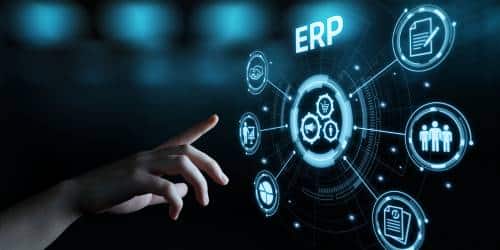“United we stand, divided we fall,” as the saying goes, relates to more than just war films and superhero TV series. It’s also an excellent illustration of why ERP integration is critical to running a successful business. Your company can streamline procedures and generate income by combining numerous “best of breed” software to construct or fortify a near-custom ERP solution. So, what precisely is ERP software, and what does integration in this context imply? In this article, we will explore these basic definitions along with ERP system strategy and integration between CRM and ERP software systems.
What is ERP (Enterprise Resource Planning)?
An ERP system is a type of software that allows businesses to collect, store, manage, and analyze information and documents relevant to business activities.
These activities can be classified as follows:
- Supply chain management: Supply chain management entails keeping track of the status of goods and services throughout your supply chain and working directly with vendors and suppliers.
- Order management: Order management entails converting a quote into a sales order and then sending a system-generated invoice to the new client as quickly as possible.
- Procurement: Create RFPs quickly, transmit them to approved suppliers, collect answers, and deliver purchase orders once the vendors are chosen.
- Analytics: View many forms of data through a single dashboard to improve decision-making in areas such as pricing, inventory management, customer assistance, and so on.
There are innumerable other ways to use an ERP system, but these examples demonstrate how versatile and powerful the software is. Furthermore, this adaptability explains why the platform is used for a wide range of corporate operations.
Finally, ERP systems can be accessible in the cloud, on-premises, or as part of a hybrid deployment. However, with the growing need for cloud-based software, ERP vendors are rapidly shifting to the cloud—if they haven’t already.
What is ERP Integration?
Now that you understand what an ERP is and how to select the best ERP software, you should investigate ERP Integration.
ERP Integration is simply the process of connecting and synchronizing your ERP software with other business applications such as eCommerce (front-end), CRM (Customer Relationship Management), EDI (Electronic Data Interchange), marketing tools such as analytics, and other databases and data points with which your company operates.
In short, connecting all of the points a business uses to enter, manage, track, and produce meaningful and important data. An eCommerce storefront, for example, is where a visitor submits a lead, requests a demo, and/or purchases a product.
In general, your best ERP integration solutions or software must interface with all other platforms and synchronize data from Omni-channels. That is what ERP Integration gives.
Examples of ERP integration
The following are five typical business processes that can benefit from ERP integration.
#1. Sync orders between your ERP and CRM
When an order is added to your customer relationship management (CRM) platform, it must be added to your ERP integration solution as soon as feasible. Otherwise, you risk postponing the rest of the initial phases in the client engagement, such as invoice delivery, client onboarding, and so on.
It is possible to combine ERP software with a CRM to avoid delays. From there, you can set up a workflow that makes a duplicate order in the ERP integration system whenever a new client order is placed in the CRM.
#2. Notify management when they need to approve a purchase order
Internal approvals for purchase orders are required for your team to swiftly access the resources they require. To address this business process, connect your ERP to your business communications platform and then create a workflow that works as follows: whenever a PO is submitted for review, the appropriate approvers are notified via a channel in the business communications platform and asked to review the document.
#3. Create an invoice in your ERP once it arrives in your spend management system
To expedite invoice processing and ensure that no payment is late—or worse, never made—you may integrate your ERP solution with a spend management tool and set up a workflow in which a duplicate invoice is issued in the ERP whenever an invoice arrives in the spend management tool.
#4. Manage important documents in your ERP without leaving your file storage app
It can be difficult to keep track of all the documents in your ERP and make changes to any of them over time. You may find anything faster by integrating the platform with a storage app you’re familiar with. Once integrated, you can rapidly share documents from the ERP with the storage app, as well as have changes made in one platform seamlessly transfer across to the other.
#5. Streamline refunds once a request arrives in your ITSM tool
Providing a world-class customer experience entails responding rapidly to client demands. Refunding is no exception. To expedite this process, connect your ERP to an ITSM and have the former immediately commence the process as the customer-facing employee creates the request in the latter.
What are the Benefits of ERP Integration?
The following are some of the advantages of ERP integration:
#1. It allows you to get rid of data silos.
Data silos, which occur when information is only available in specific apps, can have a wide range of negative consequences for you and your colleagues.
- Employees may be ignorant that specific data exists, preventing them from making use of it.
- Employees may encounter delays in getting the data they require, resulting in consequences that have an impact on the bottom line (e.g., a slow lead response time).
- Employees may eventually abandon seeking data access if they encounter the time delays and bottlenecks that occur with any request.
A well-integrated ERP integration system may efficiently prevent and dissolve data silos. Why? Because once the app is linked to others, employees may be able to obtain the data they require from it within the apps they already use. This applies to a wide range of teams, including marketing, finance, supply chain, human resources, and sales.
#2. It enables you to keep a legacy ERP system.
In many circumstances, your legacy system is still important; it just has an antiquated user interface. By integrating it with a modern UI, such as one designed in a platform like OutSystems, you may keep the benefits it provides while avoiding the awkward UI and the large costs associated with replacing it.
#3. It assists your team in avoiding costly human errors.
Your team would be forced to undertake considerable app hopping and data entering if you did not integrate your ERP software with the rest of your apps and allow data to flow effortlessly between them. These manual processes expose your team to costly blunders, such as wrongly filling out a PO, issuing a refund to the wrong client, and so on.
#4. It enhances employee satisfaction
Employee engagement can be increased by allowing employees to focus less on monotonous, manual tasks and more on smart, business-critical projects.
Higher employee engagement, in turn, is likely to result in a slew of advantages for your company, such as increased employee productivity or lower attrition.
#5 It improves the client experience.
Your team is more likely to deliver first-rate client experiences if internal bottlenecks in client-related activities are removed.
Furthermore, by keeping all client data consistent and up to current in real-time throughout your apps, your teams can collaborate more effectively in helping clients and troubleshooting any issues that arise. For example, a customer success representative may be having difficulty collecting the initial invoice payment from a client. They can notify a finance colleague, who can quickly confirm this, and subsequently extend the client’s payment date in the ERP integration system.
Different Types of ERP Integration
Although numerous types of business software can be coupled with ERP, guaranteeing ERP System connectivity with the following important applications is critical. ERP Integrations are classified based on the business objective they serve, the pain point they address, and the platforms they interface with.
#1. eCommerce ERP Integration
In terms of organization, data collection should always be linked to implementation. The eCommerce store – the point at which your business communicates with its intended clients – is where the majority of the customer data or those that are external to the organization originate. At eCommerce, data such as leads, customers, orders, transactions, and shipping statistics are generated.
#2. CRM ERP Integration
CRM software is used to acquire and manage prospect and customer data such as contact information, account details, and sales possibilities. Data integration between CRM and ERP software systems provides ERP users with better visibility into sales funnel leads, records and accounts for customer information and data, and tracks and accounts for sales levels by customer after-sales conversion. This is caused by a breakdown in communication between your ERP program and the CRM application. That is why ERP and CRM integration is critical, primarily for generating synergy between Demand (CRM) and Supply (ERP).
Common Benefits of CRM ERP Integration:
- Teams can work together to achieve a customer requirement.
- Sales funnel conversions and performance have been improved.
- Customer pleasure results from prompt and effective customer service.
- Because of linked ERP CRM systems, customers’ information is consistent across systems and departments.
#3. Project Management Integration with ERP
Project management is another essential task for any firm, particularly large ones. It contains all information about the current project, including who works on what tasks, deadlines, and other activity-related information.
#4. Business Intelligence Integration with ERP
Business intelligence software can assist your firm in reaching new heights. It helps by offering insights on a variety of fronts that aid stakeholders in making decisions about new feature introduction, business diversification, new product launch, market penetration in new areas, predictions and targets for the future fiscal year, and so on.
#5. EDI ERP Integration
Electronic Data Interchange (EDI) is a framework that enables electronic data exchanges in a predefined format between companies such as trading partners, suppliers, distributors, and others.
How do you develop an ERP integration strategy?
Working through the following questions in sequential order (and on a recurrent cycle, such as every 6 months) will help you establish a powerful approach over time:
#1. What are the business goals of the ERP integration?
If the goal is to improve the efficiency of existing processes, you may be able to rely on your in-house integration team to create and manage the solution. If, on the other hand, you want to innovate a finance or sales-related process, you should probably involve the business team (since they are most likely to grasp the process and the accompanying applications).
#2. What are your ERP integration use cases?
Answering this question can help you identify the applications you need to link to your ERP system and which teams you need to include.
#3. What are the nonfunctional requirements for your ERP integrations?
In other words, you must specify how you expect your ERP connectors to behave in terms of availability, security, and scalability, among other metrics.
#4. What type of platform should you adopt?
Based on your business objectives and nonfunctional requirements, you should be able to identify the integration solutions that best meet your needs.
Challenges in ERP Integration
The following are some of the most significant ERP integration challenges:
- Choosing the Best ERP Integration Strategy
- Keeping your ERP Integration
- ERP System Integration Expertise
- Including Personalization
- Data Standardization Across Applications
What are Three Approaches to ERP Integration?
There are numerous ERP deployment methods, but the three most common are point-to-point (P2P) integrations, enterprise service bus (ESB), and integration platform as a service (iPaaS).
What is ERP vs CRM?
ERP assists businesses in running successful operations by integrating their financial and operational systems into a centralized database, whereas CRM assists businesses in managing how customers engage with their organizations. Both serve as crucial data storage facilities.
How does ERP Integrate with an Organization?
ERP integration is the process of linking your ERP system to another piece of software in your firm. The integration allows your systems to communicate vital data and information for numerous business activities. It is a method of automating regular processes and enhancing overall corporate productivity.
What are the 4 Major Phases of ERP Implementation?
Four ERP Implementation Strategies are as follows:
- Big bang
- Phased rollout
- Parallel adoption
- Hybrid
What are the 4 Types of ERP Architecture?
The four types of ERP architecture are as follows:
- The Monolithic Architecture of ERP
- The Postmodern Architecture of the ERP System
- Cloud-Based ERP Software
- On-Premise ERP
Is SAP a CRM or ERP?
Salesforce and SAP are both established CRMs that provide the standard CRM functionality such as sales force automation, pipeline management, and SaaS or cloud access. They assist sales representatives and managers in streamlining workflows and tracking leads in order to optimize sales operations.
Is SAP an ERP System?
SAP is regarded as the market leader in cloud-based operational ERP. Discover the benefits of cloud ERP for your business operations and why SAP was named a Leader in cloud-enabled ERP software.
Is Salesforce a CRM or ERP?
While Salesforce is the world’s leading customer relationship management (CRM) platform, it is not an Enterprise Resource Planning (ERP) solution.
Conclusion
ERP system integration must shift and develop as technology does. This encompasses the tools available for ERP integration as well as the actual implementation methodologies. Because of the postmodern ERP strategy, ERP integration is currently increasing.If you have been with us this far, you will have learned everything there is to know about ERP Integration.
- 5 Reasons Why ERP Software Is Important for Growth
- DATA INTEGRATION: Definition, Applications and Tools
- 2023 Best 15+ SMALL BUSINESS ERP SYSTEMS (Updated)
- ERP SYSTEMS: Top Best Options in 2023 (Updated!!)
- BUSINESS SOFTWARE SOLUTION: Explained !![+ Free Tips]
- CUSTOMER ACQUISITION COST: Definition, Formula, Calculations & Difference






